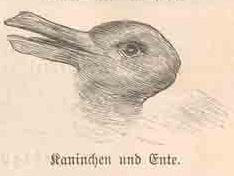What Do You See
 I surfed Mahalanobis Blog yesterday and came across this brilliant small peace of psychological “illusion”: a duck-rabbit figure by an American psychologist, Joseph Jastrow. Tell me, what animal is depicted by the figure beside?
I surfed Mahalanobis Blog yesterday and came across this brilliant small peace of psychological “illusion”: a duck-rabbit figure by an American psychologist, Joseph Jastrow. Tell me, what animal is depicted by the figure beside?The illusion evoked my memory of an old story of blind people trying to recognize the shape of an elephant. After touched the animal's trunk one said it was a long fat rope-like creature. Another said indeed it was rope-like but very slim -- he fortunately found the tail. And the other blind said the creature was like a wall, a tree, or a large leaf since they only touched the body, leg, and ear.
Perception to my understanding is build upon information people known before. That is why the blind define the elephant by comparing it to other creatures or things they have known. Problem arose when they only got partial information and came out with various perceptions. Nevertheless, by asking someone else who able to see or touch the elephant comprehensively to explain the situation – that everyones only got a partial information of the animal and that the creature's shape somehow need to be redraw by compiling all their perceptions – then the problem might be solved.
But how is to explain the psychological phenomenon experienced by people “play” Jastrow's figure especially those who might recognize firstly the picture as only a duck and not a rabbit, vise versa? It is still about pre-existing information though. However, since this psychological puzzle is assumed to be played by people who aware of the shape of a duck and a rabbit, the fact that many people might perceive the figure only as a duck or a rabbit leaves us to a big question mark.
Michael Statsny, the owner of Mahalanobis Blog, has an interesting theory.
Excerpting from the reading he proposes a constructivist point of view which says that selective perception – why does someone only recognize the duck and not the rabbit -- is driven by expectation, world-knowledge, and the direction of attention.
“For example, children tested on Easter Sunday are more likely to see the figure as a rabbit; if tested on a Sunday in October, they tend to see it as a duck or similar bird”.
A smart account I think. Even though, there are spaces left for practical explanations such as: to what side of the figure do you eyes concentrate the most, left side or right side?
Anyway, I like the theory in particular the conclusion part which says: “Jastrow used the duck-rabbit to make the point that perception is not just a product of the stimulus, but also of mental activity – that we see with the mind as well as the eye”. Just like what I am doing as a journalist.

0 Comments:
Post a Comment
Subscribe to Post Comments [Atom]
<< Home